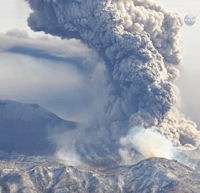Watch out for the Blue Moon

(Phys.org)—When someone says "Once in a Blue Moon," you know what they mean: Rare, seldom, even absurd.
This year it means August 31st.
For the second time this month, the Moon is about to become full. There was one full Moon on August 1st/2nd, and now a second is coming on August 31st. According to modern folklore, whenever there are two full Moons in a calendar month, the second one is "blue."
Cue up the Elvis records! "Blue Moon…. You saw me standing alone, without a dream in my heart, without a love of my own." In song and literature, blue moons have long symbolized lost love and melancholy. Elvis set the standard for lunar heartbreak in his 1956 pop hit "Blue Moon."
But will the moody Moon of August 31st actually turn blue? Probably not.
Most Blue Moons look pale gray and white, indistinguishable from any other Moon you've ever seen. Squeezing a second full Moon into a calendar month doesn't change the physical properties of the Moon itself, so its color remains the same.
With that caveat in mind, however, be aware that on rare occasions it can happen.
A truly-blue Moon usually requires a volcanic eruption. Back in 1883, for example, people saw blue moons almost every night after the Indonesian volcano Krakatoa exploded with the force of a 100-megaton nuclear bomb. Plumes of ash rose to the very top of Earth's atmosphere, and the Moon … it turned blue!
Krakatoa's ash was the reason. Some of the plumes were filled with particles 1 micron wide, about the same as the wavelength of red light. Particles of this special size strongly scatter red light, while allowing blue light to pass through. Krakatoa's clouds thus acted like a blue filter.
People also saw blue-colored Moons in 1983 after the eruption of the El Chichon volcano in Mexico. And there are reports of blue Moons caused by Mt. St. Helens in 1980 and Mount Pinatubo in 1991.
Certain forest fires can do the same trick. A famous example is the giant muskeg fire of Sept. 1953 in Alberta, Canada. Clouds of smoke containing micron-sized oil droplets produced lavender suns and blue Moons all the way from North America to England.
There are plenty of wildfires burning in the hot, dry USA this month. If any of them produce smoke with an extra dose of micron-sized particles, the full Moon might really turn blue.
On the other hand, maybe it will turn red. Often, when the moon is hanging low, it looks red for the same reason that sunsets are red. The atmosphere is full of aerosols much smaller than the ones injected by volcanoes. Measuring less than a micron in diameter, these aerosols scatter blue light, while leaving the red behind. For this reason, red Blue Moons are far more common than blue Blue Moons.
Sounds absurd? Yes, but that's what a Blue Moon is all about. Step outside at sunset on August 31st, look east at the moonrise, and see what color presents itself.
Provided by NASA



















